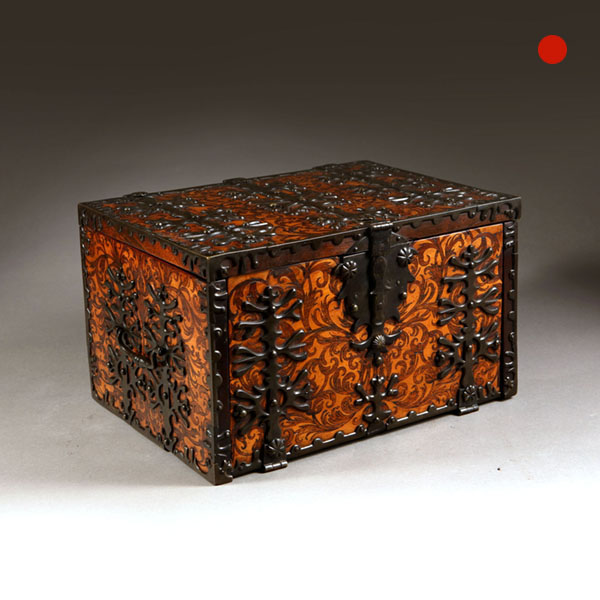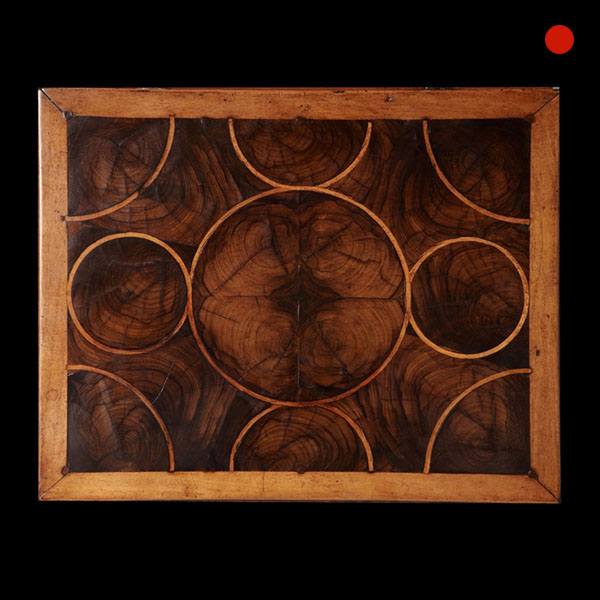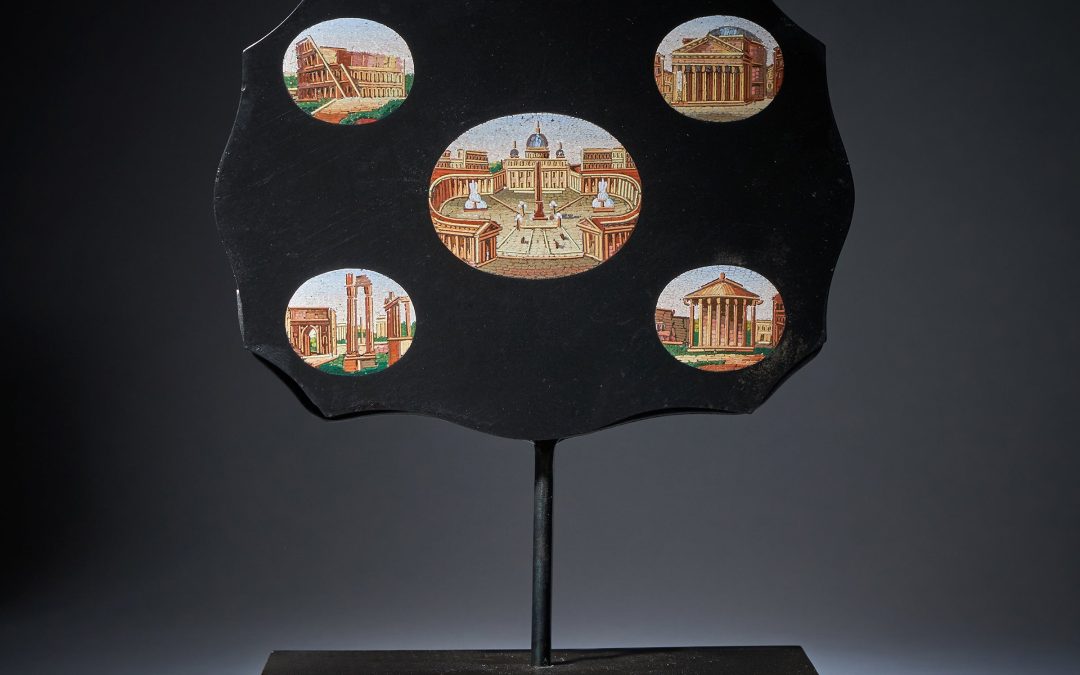A Fine and Rare Three Part George I Burr Walnut Bureau Bookcase, Circa 1720-1730. England
Sold
Follow Us
A Fine and Rare Three Part George I Burr Walnut Bureau Bookcase, Circa 1720-1730. England
Attributed to Coxed and Woster (1700-1735)
A fine George I burr walnut feather banded bureau bookcase consisting of three sections, the chest, bureau and bookcase. The bookcase is surmounted with a cavetto moulded cornice above a pair of inset moulded and shaped mirrored doors opening to reveal an arrangement of fitted double D-moulded shelves. Retractable candle slides are positioned at the base of each mirrored door.
The bureau, with applied cross-grain ogee-moulded bookrest, supported by retractable lopers divided by two short oak lined feather banded drawers, each fitted with the original gilt-brass ring-pull handles, oval escutcheons and locks. The cross-grain moulded feather-banded fall opens to reveal what is possibly the original inset leather writing surface in front of an arrangement of pigeon holes, small and long feather-banded drawers, each fitted with the original knobs. To the centre is a feather-banded cupboard between Tuscan columns concealing three hidden drawers.
The ovolo waist moulded chest is raised on ball and bracket feet. It is fitted with three graduating oak-lined feather-banded drawers, each fitted with the original gilt-brass ring pull handles, oval escutcheons and locks.
A truly rare and superb quality piece, with choice use of quality burr veneers throughout its construction.
Literature. Coxed and Woster was a partnership formed after the death of John Coxed. In his will, John left instructions for his widow, Grace, to ‘go partners’ with his brother-in-law, Thomas Woster, who was also a cabinet maker. Grace Coxed was married and widowed twice, both husbands being cabinet makers. Her first marriage was to John Mayo, who at his death left his business in the hands of his widow Grace. One of Mayo’s apprentices was John Coxed, who completed his term of indenture under Grace’s supervision on 7 September 1703. Grace managed her cabinet making business after her first husband’s death for seven years before she married John Coxed in 1707. They were married married for ten years until his death in November 1718.
Grace’s role in the business is unknown: there are no records of her activity in London Companies, or accounts of her business transactions, but she was presumably involved in running the cabinet making firm, Coxed and Woster from her second husband’s death in 1718 until she died in 1735.
A number of desks, bureaux, bureau cabinets, secretaire cabinets and chests of drawers dating from the period 1720–35 have been found with the trade labels G. Coxed & T. Woster (e.g. Colonial Williamsburg). Typically, they are veneered in walnut or burr maple and some pieces are embellished with rosewood crossbanding and pewter stringing. The fullest known trade label reads ‘G.Coxed and T.Woster At the White Swan, against the South-Gate in St Paul’s Church Yard, London, Makes and Sells Cabinets, Scrutoires, Desks and Book-Cases, Buro’s Chests of Drawers, Wisk, Ombre, Dutch and Indian Tea-Tables; All sorts of Looking-Glasses, Large Sconces, Dressing Sets and Wainscot-Work of all sorts, at Reasonable Rates. Old Glasses New polished and Made up fashionable.’
Condition
Good. Wear consistent with age and use.
Dimensions
Height: 226 cm / 89 Inches
Width: 103 cm / 40 1/2
Inches Depth: 60 cm / 23 1/2 Inches
PREVIOUSLY SOLD

William and Mary Kingwood or ‘Princes’ wood oyster cabinet on chest
When the most expensive timber of the 17th century met Thomas Pistor. There were, in fact, two cabinet-makers called Thomas Pistor, father and son, working for a period at the same time but at different premises. One or both are known to have made furniture of quality for Levens Hall.

17th Century William and Mary Kingwood Strongbox
A 17th century William and Mary Kingwood strongbox, with gilt brass straps. This strongbox has to be one of the most charming and certainly the smallest example we have encountered, at just 17.5 cm high, 28 cm wide and 18 cm deep. A strongbox of similar merit form and style resides at Burghley House in ‘The 1st George State Room.

William and Mary Seaweed Marquetry Strong Box Firmly Attributed to Gerrit Jensen
A 17th century William and Mary seaweed or arabesque marquetry strong box, with firm attribution to the royal cabinetmaker, Gerrit Jensen, circa 1680-1700, England.

18th Century George III Mahogany Serpentine Chest or Commode
A fine George III mahogany serpentine commode, England, circa 1770. Attributed to Henry Hill, Marlborough. The three graduated drawers retain their original gilt brass handles over a unique carved apron and flanked by moulded angles continuing into the shaped cabriole feet.

William and Mary Olive Oyster Lace Box
Fabulous 17th-century olive oyster ‘lace box’. ‘Lace boxes’ were popular amongst the middle and higher classes of society from C.1660-1700. The olive oyster box we have for offer here is a lovely original and unusually small example, at just 12″ wide. This form dates from circa 1680-1700.

George III Mahogany Serpentine Chest of Drawers
Georgian perfection, 18th century George III mahogany serpentine chest of drawers with brushing slide, fabulous reeded columns and retaining superb original age patinated surface. Choice cuts of flame mahogany veneer sit below the brushing-slide to the four oak lined cock-beaded graduating drawers, which are fitted with their original gilt swan-neck handles, skeleton escutcheons and locks.

William and Mary Kingwood or ‘Princes’ wood oyster cabinet on chest
When the most expensive timber of the 17th century met Thomas Pistor. There were, in fact, two cabinet-makers called Thomas Pistor, father and son, working for a period at the same time but at different premises. One or both are known to have made furniture of quality for Levens Hall.

17th Century William and Mary Kingwood Strongbox
A 17th century William and Mary Kingwood strongbox, with gilt brass straps. This strongbox has to be one of the most charming and certainly the smallest example we have encountered, at just 17.5 cm high, 28 cm wide and 18 cm deep. A strongbox of similar merit form and style resides at Burghley House in ‘The 1st George State Room.

William and Mary Seaweed Marquetry Strong Box Firmly Attributed to Gerrit Jensen
A 17th century William and Mary seaweed or arabesque marquetry strong box, with firm attribution to the royal cabinetmaker, Gerrit Jensen, circa 1680-1700, England.

18th Century George III Mahogany Serpentine Chest or Commode
A fine George III mahogany serpentine commode, England, circa 1770. Attributed to Henry Hill, Marlborough. The three graduated drawers retain their original gilt brass handles over a unique carved apron and flanked by moulded angles continuing into the shaped cabriole feet.

William and Mary Olive Oyster Lace Box
Fabulous 17th-century olive oyster ‘lace box’. ‘Lace boxes’ were popular amongst the middle and higher classes of society from C.1660-1700. The olive oyster box we have for offer here is a lovely original and unusually small example, at just 12″ wide. This form dates from circa 1680-1700.

George III Mahogany Serpentine Chest of Drawers
Georgian perfection, 18th century George III mahogany serpentine chest of drawers with brushing slide, fabulous reeded columns and retaining superb original age patinated surface. Choice cuts of flame mahogany veneer sit below the brushing-slide to the four oak lined cock-beaded graduating drawers, which are fitted with their original gilt swan-neck handles, skeleton escutcheons and locks.
YOU MAY ALSO LIKE

A Fine 17th Century William and Mary Burl Walnut Cabinet on Chest, Circa 1690
A Fine 17th Century William and Mary Burl Walnut Cabinet on Chest, Circa 1690 £27,800[wpforms_selector form_id="11387" show_title="on" _builder_version="4.22.1" _module_preset="default" custom_margin="-30px||||false|false"...

19th Century Grand Tour Micro Mosaic Tablet Depicting Italian Architecture
19th Century Grand Tour Micro Mosaic Tablet Depicting Italian Architecture £3,650Follow Us19th Century Grand Tour Micro Mosaic Tablet Depicting Italian Architecture A fine mid-19th century serpentine grand tour micro mosaic tablet or...

Large William and Mary 17th Century Inlaid Olive Oyster Lace Box, Circa 1690
Large William and Mary 17th Century Inlaid Olive Oyster Lace Box £5,500[wpforms_selector form_id="11387" show_title="on" _builder_version="4.22.1" _module_preset="default" custom_margin="-30px||||false|false" global_colors_info="{}"...

Early 19th Century High Regency Brass Snake Doorstop
Early 19th Century High Regency Brass Snake Doorstop £1,100Follow UsEarly 19th Century High Regency Brass Snake Doorstop A high Regency solid brass bell-shaped doorstop with snake handle, from the reign of George IV, Circa 1770. England The...

Extremely Rare George III 18th Century Quarter-Striking Bracket Clock, Signed
Extremely Rare George III 18th Century Quarter-Striking Bracket Clock, Signed Follow UsExtremely Rare George III 18th Century Quarter-Striking Bracket Clock, Signed An extremely rare George III 18th century ebonized quarter-striking bracket...

18th Century George III Carved Mahogany Serpentine Concertina Action Card Table
18th Century George III Carved Mahogany Serpentine Concertina Action Card Table £19,800Follow Us18th Century George III Carved Mahogany Serpentine Concertina Action Card Table A bold and impressive George III carved mahogany serpentine...

A Fine 17th Century William and Mary Burl Walnut Cabinet on Chest, Circa 1690
A Fine 17th Century William and Mary Burl Walnut Cabinet on Chest, Circa 1690 £27,800[wpforms_selector form_id="11387" show_title="on" _builder_version="4.22.1" _module_preset="default" custom_margin="-30px||||false|false"...

19th Century Grand Tour Micro Mosaic Tablet Depicting Italian Architecture
19th Century Grand Tour Micro Mosaic Tablet Depicting Italian Architecture £3,650Follow Us19th Century Grand Tour Micro Mosaic Tablet Depicting Italian Architecture A fine mid-19th century serpentine grand tour micro mosaic tablet or...

Large William and Mary 17th Century Inlaid Olive Oyster Lace Box, Circa 1690
Large William and Mary 17th Century Inlaid Olive Oyster Lace Box £5,500[wpforms_selector form_id="11387" show_title="on" _builder_version="4.22.1" _module_preset="default" custom_margin="-30px||||false|false" global_colors_info="{}"...

Early 19th Century High Regency Brass Snake Doorstop
Early 19th Century High Regency Brass Snake Doorstop £1,100Follow UsEarly 19th Century High Regency Brass Snake Doorstop A high Regency solid brass bell-shaped doorstop with snake handle, from the reign of George IV, Circa 1770. England The...

Extremely Rare George III 18th Century Quarter-Striking Bracket Clock, Signed
Extremely Rare George III 18th Century Quarter-Striking Bracket Clock, Signed Follow UsExtremely Rare George III 18th Century Quarter-Striking Bracket Clock, Signed An extremely rare George III 18th century ebonized quarter-striking bracket...

18th Century George III Carved Mahogany Serpentine Concertina Action Card Table
18th Century George III Carved Mahogany Serpentine Concertina Action Card Table £19,800Follow Us18th Century George III Carved Mahogany Serpentine Concertina Action Card Table A bold and impressive George III carved mahogany serpentine...

















